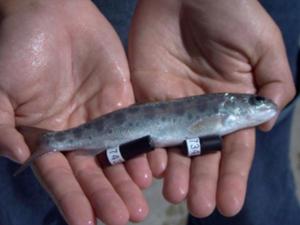forum
library
tutorial
contact

Do Dams Make A Difference?
by StaffScience Daily, October 30, 2008
|
the film forum library tutorial contact |

|
Do Dams Make A Difference?
by StaffScience Daily, October 30, 2008 |
Similar Survival Rates For Pacific Salmon In Fraser And Columbia Rivers
 Canadian and U.S. researchers have made a surprising discovery that some endangered Pacific salmon stocks are surviving in rivers with hydroelectric dams as well as or better than in rivers without dams.
Canadian and U.S. researchers have made a surprising discovery that some endangered Pacific salmon stocks are surviving in rivers with hydroelectric dams as well as or better than in rivers without dams.
This is the first study of its kind and is carried out by an international team of scientists that includes researchers from the University of British Columbia.
The team compared the survival rates of out-migrating, juvenile spring Chinook and steelhead salmon from two river basins: the heavily dammed Snake and Columbia Rivers and the free-flowing Thompson and Fraser Rivers - both critical spawning grounds for numerous salmon species.
Using technology that has only recently been available, the team electronically tagged juvenile salmon (smolts) and monitored their journey from freshwater into the ocean via a large-scale acoustic telemetry system called the Pacific Ocean Shelf Tracking (POST) array.
"It came as quite a surprise to us that the Fraser River salmon populations studied have lower survival than the Columbia River study populations," says Erin Rechisky, one of the study authors and a PhD Candidate in the UBC Dept. of Zoology. Rechisky stresses that there is not yet sufficient evidence to reach any conclusions. "Clearly dams are not good for salmon. What is unclear is whether the Fraser River has a problem that cuts salmon survival to that of a heavily dammed river, or whether factors other than dams play a larger, unsuspected role in salmon survival."
Only in recent years have acoustic tags become small enough for scientists to implant them into juvenile salmon and track them as they migrate downstream. These innovations enabled the team to gather data on salmon smolts in the Fraser River. Before that, it was only possible to measure juvenile survival where salmon gathered in dam bypasses like those in the Columbia and Snake Rivers.
The lower Columbia and lower Snake Rivers currently have eight major hydroelectric dams combined. During the late 1930s when the first dams began to go up, salmon survival rates began to plummet, hitting mortality highs during the 1960s and 1970s due to a combination of warmer waters, fish-grinding turbines and new predators. Since then, the U.S. government has invested in major restoration measures to improve salmon survival rates.
Current conservation efforts have focused on helping smolts pass through the hydropower system. However, the scientific team aims to clarify with future studies using POST technology whether dam passage in itself has long-term detrimental effects that impact salmon's ocean survival.
The researchers note that threats beyond the rivers are taking a heavy toll on salmon. These include habitat destruction, competition with hatchery fish, harvesting and large-scale changes in ocean climate.
The study's lead author is David Welch, Kintama Research Corp., based in Nanaimo, B.C. Along with Rechisky, co-authors are: Michael Melnychuk, UBC Zoology PhD student; Prof. Carl Walters, UBC Fisheries Centre; Prof. Scott McKinley, UBC Land and Food Systems and Canada Research Chair, Aquaculture and the Environment; Aswea Porter, Kintama Research; Oregon State University and the U.S. Geological Survey's Shaun Clements, Benjamin Clemens, and Prof. Carl Schreck.
Journal reference:
Welch DW, Rechisky EL, Melnychuk MC, Porter AD, Walters CJ, et al. Survival of migrating salmon smolts in large rivers with and without dams. PLoS Biol, 6(10):e265 DOI: 10.1371/journal.pbio.0060265
Adapted from materials provided by University of British Columbia.
Related Pages:
Biodiversity: Unraveling the Mysteries of Salmon Migration
by Stephen Leahy, Science Daily, 10/31/8
Do Dams Make A Difference?
IPS News, 10/30/8
Salmon Study Yields Surprise Result
by Jeff Barnard,
Capital Press, 10/30/8
Readers Discuss POST article
by Reader Discussion,
The Oregonian, 10/29/8
Salmon: No Dam Difference?
by Editorial Board,
The Oregonian, 10/29/8
Track the Salmon in California
by Editorial Board,
Contra Costa Times, 10/29/8
New Study Finds Fish Do as Well on Dammed Rivers
by Editorial Board,
Walla Walla Union-Bulletin, 10/29/8
Dams Appear to Have No Impact on Salmon
by Michael Reilly,
Discovery News, 10/29/8
Salmon Smolt Survival Similar in Columbia and Fraser
by Mark Floyd,
Eureka Alert, 10/27/8
Salmon Study Under Fire for Minimizing Effect of Dams
by Warren Cornwall,
Seattle Times, 10/27/8
Research Hints Dam Improvements Helping Salmon
by Michael Milstein,
The Oregonian, 10/27/8
Dams Not Main Cause of Salmon Collapse, Study Says
by James Owen,
National Geographic News, 10/27/8
Study Shows More Salmon Survive West's Dammed Rivers
Canadian Press, 10/27/8
Radio Tags Shed Light on Salmon Migration Routes
by Mark Hume,
Globe and Mail, 10/27/8
learn more on topics covered in the film
see the video
read the script
learn the songs
discussion forum
